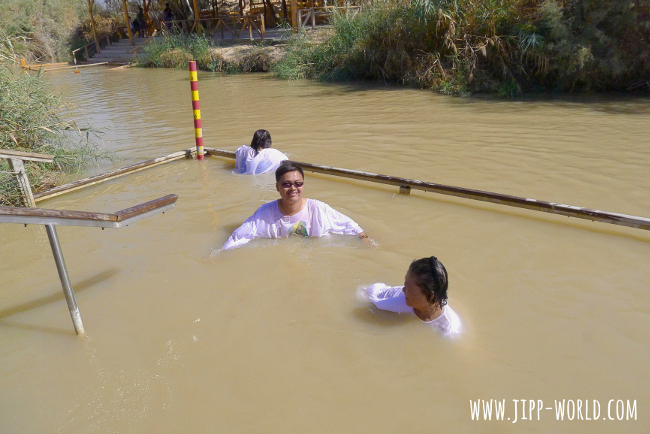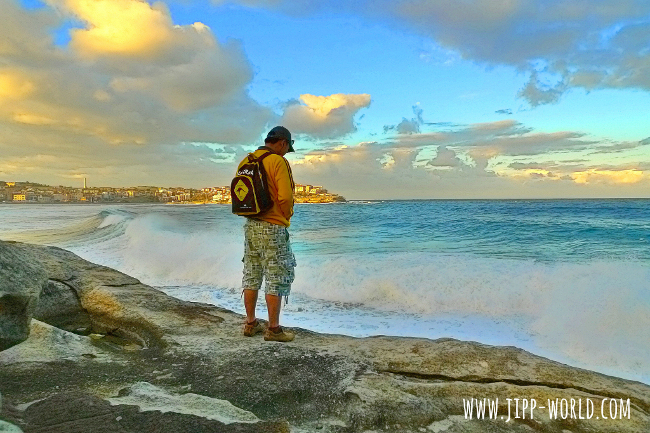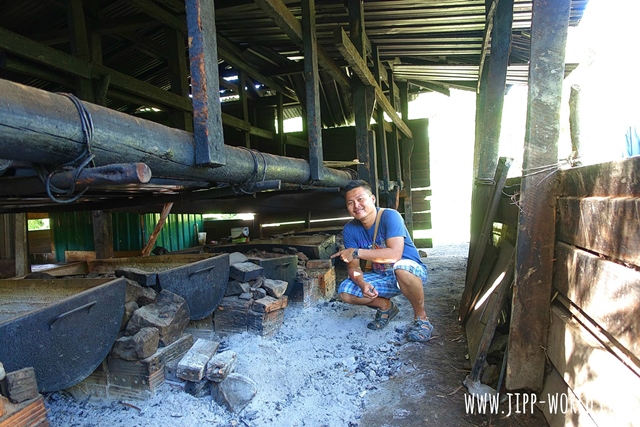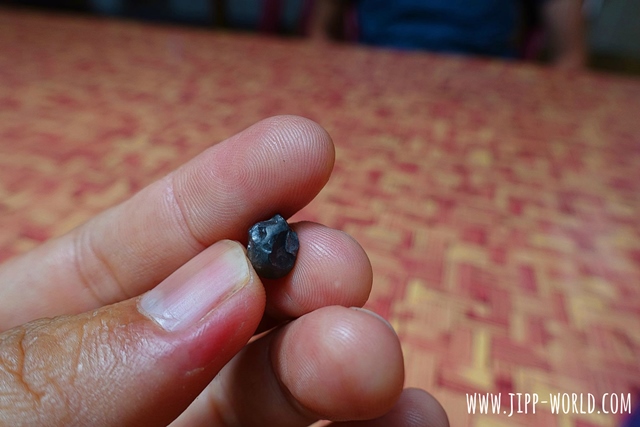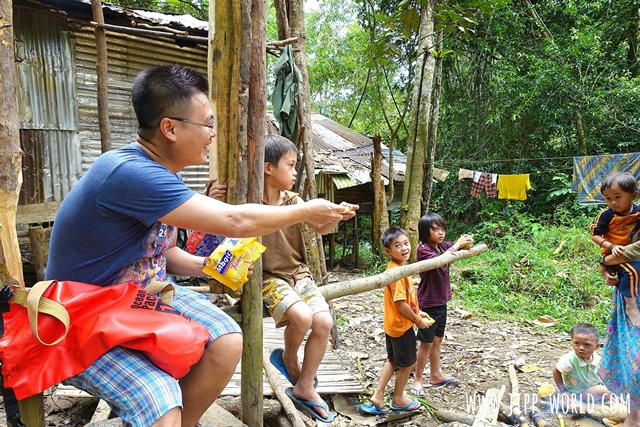The Salt Trail – I grew up listening to my mother talking about it. Her story of how she as a child had to tag along behind her parents and a group of others to walk for days from her remote village in the far corner of Tambunan all the way to Tamparuli on the West coast of Sabah just to buy salt. It never failed to fascinate me every time.

Tikolod-Kionop-Terian-Inobong
She told me how she would usually be assigned to carry some of the food supply. She’d cry because it felt so heavy on her back and sometimes she’d get bitten by ants and all kind of insects along the way. They had to walk across mountains and hills and deep valleys through thick and dense forest. They’d stop whenever they felt like stopping usually when it was too dark to continue walking. They’d set up their temporary tents, usually by stacking banana leaves on tree branches under which they would take a nap before continuing walking the next day. I never get bored of listening to her stories about the Salt Trail as it is now known.
The idea of doing the salt trail had always been in my wish list for such a long time but it only got materialized when my application for 2-weeks Christmas and New Year holidays was surprisingly approved by my management. I hastily contacted my friend Frankie to ask if he could get a few more others to join. The rest as they say – is history. Heh.

We started our trek from the starting point in Tikolod on the Tambunan side, and walked all the way to a place called Kionob on the Penampang side where we stayed overnight before trekking on to a village called Terian – but not before crossing through a beautiful village called Buayan – to spend another night before continuing on to our last stop at Inobong Sub-station.
The trek between Tikolod and Kionob was quite a tough one for us especially for the fact that we didn’t hire any porter so we had to carry ourselves all the necessities to survive through 2 nights in the deep forest. The forest really is so beautiful. It is so lush and green and mystical and mysterious that it quickly made me realize how blessed this land called Sabah is and that most of its beauty lies deep in its pristine forests. After all the forest that we trekked across is part of the Crocker Range which is a declared National Park.

I like to believe that it is a secondary forest though – a leftover of extensive logging activities in the past, just like most other forests in Sabah so it was a no surprise then that we didn’t even come across any wild animals. The only wildlife that we came across was a snake – probably a cobra, a very poisonous one according to the guide – and I almost freaked out when I spotted it because it was so close to being stepped on by one of my trekking buddies. Seriously, it could have been fatal. Phew.
But of course, the very first challenge that we came upon was the existence of so many leeches along the way. They’d crawl all over and they were almost impossible to avoid. We’d stop every now and then to take them out because who knows how much of our blood would be sucked out of our system if we let them suck for too long. The thing is, they tend to be very itchy and they’d bleed so profusely, leaving my skin with ugly scars that would stay there for weeks if not months (I’ve still got them now!).
One of my favorite things while trekking the Salt Trail was the food. I mean, we all know that food is tastier in a jungle but even more so if it is the right food that you eat. My trekking buddy Din really looked into that by bringing those kinds of food that really boost the appetite when eaten in the deep forest. The likes of fried salted fish, grilled wild boar meat, those foods that really really open the gate of appetite especially when eating in a jungle.

I have come to find out then that it is always a good idea to bring somebody who is handy and good at cooking and preparing food. Din really knew how to put things in. He always came up with an idea or two to make the food even more tasty and delicious than they already are. There was one time when we walked across an abandoned village and found a mango tree which was heavy with fruits and we actually plucked some of them off which he then sliced up into pieces and became part of our lunch. Then there was a wild fruit – a very sour one – which he also plucked off from the tree and made them part of our dinner. They were all so good to come with rice so much so that I couldn’t even stop eating and almost passed out from too much eating.
One of the best parts of the trekking was the night we spent at Kionob. We stayed at a wooden double-storey building which we later found out was once a chapel but has now been abandoned and taken over by Sabah Parks. It is quite well maintained with all basic cooking facilities, complete with shower rooms and a make shift toilet. Apart from a large table and a full set of gongs, the chapel is almost empty now. I was so glad that I had brought with me a sleeping bag to protect myself from the hard wooden floor and the cold night air. I had also brought with me a small bottle of Tequila so we had something to do at least until we were sleepy enough to be able to doze off. Despite the tiredness, I found it quite difficult to put myself to sleep.

One of the most interesting things about the trek is the abandoned villages that we had to walk across while trekking from Tikolod to Kionob and later to Buayan. It really felt strange to be walking past big empty houses and farms and many more signs of human occupation in the past.
I was told that the villagers had to leave because the area was taken over by Sabah Parks and was closed off to any public encroachment (although the guide argued that they were there long before it was declared a protected area) since then. Besides, the area was almost totally out of reach so it was only natural that they all shifted to areas that were closer to modern civilization. There was one old couple – a sister and a brother – who had opted not to move out and they still stayed there. My heart broke when the guide showed to us their place of residence. It was more like a shack – a very run-down one – and it looked to me like it was very much on the verge of collapsing. I took a picture of the house and for a moment I really thought I saw a woman peeking through a hole by the window. Somehow I felt a chill oozing up the back of my neck when I saw her.

One of the main challenges while trekking the Salt Trail was the river-crossing that we had to do several times along the way. We were lucky because it didn’t rain so the river-crossing was quite manageable. It was still quite challenging though, especially when I had to protect with all my might the bag from getting wet. I had to put everything digital inside my dry bag just in case and sure enough, I stumbled at one time and drenched myself up. Luckily my camera had remained intact. Phew.
The walk from Kionob to Buayan was easier but it was quite a long way before we arrived at the famous village called Buayan. It really was a beautiful village, perched on a riverbank that plunges deep into the river itself – which is one of the most beautiful rivers that I’ve ever seen in my entire life. Sadly enough though, it is the very river that they are going to block off as part of a very controversial project called Kaiduan Dam. The dam, if proceeding, will submerge the whole area and permanently wipe out all the beauty that we see now. This Kaiduan Dam is one of the very reasons why I decided to do the Salt Trail walk quite sooner instead of later because I wanted to see it all before it was all gone.

Then the walk across the paddy fields was also one of the highlights. Backdropping against the beautiful green hills in the background, they really were made for picture postcards. Then those hanging bridges. I’ve never seen longer hanging bridges anywhere else before so walking on them really made me so excited than I probably wanted to. LOL.
Then the overnight stay at Terian. We stayed at the community hall as part of the package and we actually had it all to ourselves. The community of Kg Terian had prepared all the cooking facilities including a clean kitchen, a double-stove and all the necessary utensils. The community hall was located very much nearby a river so we had all the fun in the world taking a dip and swimming (albeit stationary) in the rather cold but refreshing water. It really was such a relaxing time after such a long long day. Every now and then the silence would be broken by a group of kids who were all happy to see a bunch of new faces within the vicinity.

I really liked the night at Terian. It was full-moon and yet I could see dots of stars scattered all over the beautiful night sky. We bought a carton of beer from the villagers over which we had a long night chat and laughed like crazy whenever something funny came up in between the conversation. That one carton was enough to put us to sleep – something that we desperately needed because it wasn’t easy to get a decent night sleep when you are too tired and having sore muscles all over the body after trekking all day long.
The last part of the trail from Terian back to Inobong Sub-Station was probably the toughest one. I mean, it was more like walking across a bush and farms and rubber plantations but the uphill treks were fast to suck the hell out of us. Thanks God we had by now gotten rid of most of our food stuff so our backpacks were much lighter than they were before. But still, it was quite a struggle. We’d stop every now and then to catch our breath and it was one of those times when I had to summon up all the courage to go on. But of course, we had to finish what we had started.

When we finally reached the end-point at Inobong Sub-Station, we were all jubilant. I could hardly believe that we had actually walked from Tambunan all the way to Penampang through mountains and valleys and all that comes in between. On the other hand, it really was such an eye-opening experience – a reminder of how difficult it was for our ancestors to get hold of salt – something that we could simply buy from any of the marts or convenience stores nowadays. It was such a humbling experience too.
The Salt Trail in the Crocker Range also showed to me how Sabah is NOT all about Mount Kinabalu or Sipadan alone but a combination of so many other attractions. We’ll just have to digger deeper to find more of them and The Salt Trail probably one of the best platforms that could take you to (some of) them.
A little bit of information on the arrangement to the Salt Trail
It’s easy peasy. You can directly contact the Sabah Parks mini office at Inobong Sub-Station to do the arrangement. Some fees apply – mostly on paying for the guide and probably a porter if you want to trek light. They’d get a local guide – usually from any of the villages along the trail – and they are usually readily available. It usually takes 4 days and 3 nights, with the first night is to drive up to the starting point at Tikolod in Tambunan and spend the first night there. The trekking only begins the next day. Since we were all from Keningau which is quiet close to Tikolod, we only went to Tikolod in the morning so we only spent 2 nights doing the trek. Well, most trekkers bring their own food stuff and they’d cook, like how we did. Cooking facilities are actually available at every overnight stop (Kionob and Terian) so you don’t really need to bring your stove etc, unless you want to experience cooking in the jungle.
But of course, if you want to make things much easier for you, you can contact any of the local tour companies and they’ll arrange everything for you. A little bit of extra on the expenses may be, but for sure things will be much easier. Besides, it’s a way of supporting our local tourism industry which was hit quite hard by some unfortunate incidences these past few years. Buli bah kalo kao!



